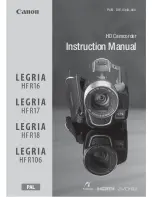
25
Sync exposure using IEEE1588
When the timestamp on the camera is synchronized with the IEEE1588 master, the camera can start exposure by
synchronizing with it.
On the firmware version 1.1.0 or later, if you set the trigger source to PTP, the camera starts synchronization only by
setting the trigger interval. To synchronize with the camera of version 1.0.0, the synchronization start time should be set
as well. The trigger interval can be set in 1ms units.
Sync start time is set by 32 bit values of seconds when time is represented by epoch time.
Time settings on Master
As the camera itself doesn’t have a real-time clock, its internal watch starts working at the time the power is turned on
as 1/1/1970 0:00. However, the current time can be set on the camera which works as the master for IEEE1588. The
current time is 64 bit values of the epoch time represented by seconds multiplied by 1,000,000,000. Write this value on
2 registers in 32 bits each then perform settings with the time set command on the camera. This time setting is a
simplified setting and there is no way to set the complete time on the camera. You can synchronize between cameras
without setting the time of the master.
As the time is important when you use schedule action commands, we recommend setting the time on the master.
Starting exposure with the set time synched with IEEE1588
You can start exposure by setting the absolute time.
Only 1 time can be registered. The next exposure can be reserved when the exposure starts.
As with the setting of the IEEE1588 master time, the time is reserved by writing the epoch time expressed in seconds
and multiplying it by 1,000,000,000 (64 bits) into two 32 bit registers and sending the time set command. If the past
time has been passed, the exposure starts immediately.
GPO output with setting time synched with IEEE1588
You can output the signal to the GPO connector by setting the absolute time.
1 time can be registered. The next output can be reserved when the signal is output.
As with the setting of the IEEE1588 master time, the time is reserved by writing the epoch time expressed in seconds
and multiplying it by 1,000,000,000 (64 bits) into two 32 bit registers and sending the time set command. If the past
time has been passed, the exposure starts immediately.
The signal flips the current condition.
Register
Parameter
Setting
PTPTriggerInterval
Interval time
Trigger interval (ms)
PTPTriggerStartTime
Start time
Sync start time (sec.)
Register
Parameter
Setting
PTPMasterTimeInitialValueHigh
Time
Upper 32 bits
PTPMasterTimeInitialValueLow
Time
Lower 32 bits
PTPSoftwareTriggerTimeSet
-
Time set command
Register
Parameter
Setting
PTPSoftwareTriggerTimeHigh
Time
Upper 32 bits
PTPSoftwareTriggerTimeLow
Time
Lower 32 bits
PTPSoftwareTriggerTimeSet
-
Time set command
Register
Parameter
Setting
PTPSoftwareTriggerTimeHigh
Time
Upper 32 bits
PTPSoftwareTriggerTimeLow
Time
Lower 32 bits
PTPSoftwareTriggerTimeSet
-
Time set command
















































